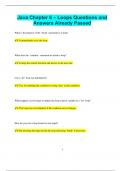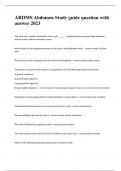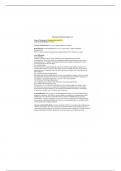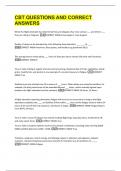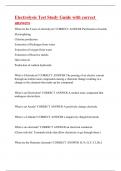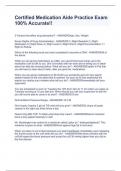Biological Molecules
All life on Earth shares a common chemistry. This provides indirect evidence for evolution. Despite
their great variety, the cells of all living organisms contain only a few groups of carbon-based
compounds that interact in similar ways. Carbohydrates are commonly used by cells as
respiratory substrates. They also form structural components in plasma membranes and cell walls.
Lipids have many uses, including the bilayer of plasma membranes, certain hormones and as
respiratory substrates. Proteins form many cell structures. They are also important as enzymes,
chemical messengers and components of the blood. Nucleic acids carry the genetic code for the
production of proteins. The genetic code is common to viruses and to all living organisms, providing
evidence for evolution. The most common component of cells is water; hence our search for life
elsewhere in the universe involves a search for liquid water.
,Monomers & Polymers
Specification Notes
The variety of life, both past and present, is extensive, but the biochemical basis of life is similar for
all living things. Monomers are the smaller units from which larger molecules are made. Polymers
are molecules made from a large number of monomers joined together. Monosaccharides, amino
acids and nucleotides are examples of monomers. A condensation reaction joins two molecules
together with the formation of a chemical bond and involves the elimination of a molecule of water.
A hydrolysis reaction breaks a chemical bond between two molecules and involves the use of a
water molecule.
Key Definitions
Metabolism All of the chemical processes that take place in living organisms.
Monomers The smaller units from which larger molecules are made.
Polymers Molecules made from a large number of monomers joined together.
Types Of Bonding
Covalent Bonding Atoms share a pair of electrons in their outer shells to form a more stable
compound, called a molecule.
Ionic Bonding Ions with opposite charges attract each other and an electrostatic force of
attraction is formed, called an ionic bond.
Hydrogen Bonding A weak electrostatic force of attraction is formed when the positive end of
one polar molecule attracts the negative end of another polar molecule.
Examples Of Polymers & Their Monomers
Monomer Polymer
Monosaccharide Polysaccharide
Mononucleotide Polynucleotide
Amino Acids Polypeptides
Condensation Reactions
When a polymer is formed by polymerisation in living organisms, subunits are joined with the
removal of a water molecule to create a bond.
Hydrolysis Reactions
When a polymer is broken down into its constituent monomers in a living organism, a water
molecule is added to break the bond between the monomers.
,Moles & Molar Solutions
A mole (mol) is the standard unit for measuring the amount of a substance. One mole contains
the same number of particles as there are in 12g of carbon-12 atoms.12g of carbon-12 atoms
contains 6.022 x 1023 carbon atoms. This number is called Avagadro’s constant.
A Molar Solution (M) is a solution that contains 1 mole of solute in each litre of solution.
,Carbohydrates
Specification Notes
Monosaccharides are the monomers from which larger carbohydrates are made. Glucose,
galactose and fructose are common monosaccharides. A condensation reaction between two
monosaccharides forms a glycosidic bond. Disaccharides are formed by the condensation of two
monosaccharides:
Maltose is a disaccharide formed by condensation of two glucose molecules. Sucrose is a
disaccharide formed by condensation of a glucose molecule and a fructose molecule. Lactose is a
disaccharide formed by condensation of a glucose molecule and a galactose molecule.
Glucose has two isomers, α-glucose and β-glucose, with structures:
Polysaccharides are formed by the condensation of many glucose units.
Glycogen and starch are formed by the condensation of α-glucose. Cellulose is formed by the
condensation of β-glucose.
You need to know the basic structure and functions of glycogen, starch and cellulose, and the
relationship of structure to function of these substances in animal cells and plant cells.
The biochemical tests include using Benedict's solution to test for reducing sugars and
non-reducing sugars and iodine/potassium iodide to test for starch.
Key Definitions
Disaccharides Molecules formed by the condensation of two monosaccharides.
Polysaccharides Molecules formed by the condensation of many monosaccharides.
Glycosidic Bond A bond between two monosaccharides formed in a condensation reaction.
Monosaccharides
Carbohydrates in general consist only of carbon, hydrogen and oxygen. Monosaccharides are
generally soluble in water and typically have the general formula (CH2O)n where n can take any
value from 3 to 7. Common monosaccharides include glucose, galactose and fructose.
, Glucose
Glucose is a monosaccharide which has two isomers, alpha and beta. Glucose is an important
hexose sugar as it is the main substrate for respiration.
Disaccharides
A disaccharide is formed when two monosaccharides join together in a condensation reaction to
form a glycosidic bond between them with the removal of a water molecule.
Common Disaccharides
Glucose + Glucose → Galactose
Glucose + Fructose → Sucrose
Glucose + Galactose → Lactose
All life on Earth shares a common chemistry. This provides indirect evidence for evolution. Despite
their great variety, the cells of all living organisms contain only a few groups of carbon-based
compounds that interact in similar ways. Carbohydrates are commonly used by cells as
respiratory substrates. They also form structural components in plasma membranes and cell walls.
Lipids have many uses, including the bilayer of plasma membranes, certain hormones and as
respiratory substrates. Proteins form many cell structures. They are also important as enzymes,
chemical messengers and components of the blood. Nucleic acids carry the genetic code for the
production of proteins. The genetic code is common to viruses and to all living organisms, providing
evidence for evolution. The most common component of cells is water; hence our search for life
elsewhere in the universe involves a search for liquid water.
,Monomers & Polymers
Specification Notes
The variety of life, both past and present, is extensive, but the biochemical basis of life is similar for
all living things. Monomers are the smaller units from which larger molecules are made. Polymers
are molecules made from a large number of monomers joined together. Monosaccharides, amino
acids and nucleotides are examples of monomers. A condensation reaction joins two molecules
together with the formation of a chemical bond and involves the elimination of a molecule of water.
A hydrolysis reaction breaks a chemical bond between two molecules and involves the use of a
water molecule.
Key Definitions
Metabolism All of the chemical processes that take place in living organisms.
Monomers The smaller units from which larger molecules are made.
Polymers Molecules made from a large number of monomers joined together.
Types Of Bonding
Covalent Bonding Atoms share a pair of electrons in their outer shells to form a more stable
compound, called a molecule.
Ionic Bonding Ions with opposite charges attract each other and an electrostatic force of
attraction is formed, called an ionic bond.
Hydrogen Bonding A weak electrostatic force of attraction is formed when the positive end of
one polar molecule attracts the negative end of another polar molecule.
Examples Of Polymers & Their Monomers
Monomer Polymer
Monosaccharide Polysaccharide
Mononucleotide Polynucleotide
Amino Acids Polypeptides
Condensation Reactions
When a polymer is formed by polymerisation in living organisms, subunits are joined with the
removal of a water molecule to create a bond.
Hydrolysis Reactions
When a polymer is broken down into its constituent monomers in a living organism, a water
molecule is added to break the bond between the monomers.
,Moles & Molar Solutions
A mole (mol) is the standard unit for measuring the amount of a substance. One mole contains
the same number of particles as there are in 12g of carbon-12 atoms.12g of carbon-12 atoms
contains 6.022 x 1023 carbon atoms. This number is called Avagadro’s constant.
A Molar Solution (M) is a solution that contains 1 mole of solute in each litre of solution.
,Carbohydrates
Specification Notes
Monosaccharides are the monomers from which larger carbohydrates are made. Glucose,
galactose and fructose are common monosaccharides. A condensation reaction between two
monosaccharides forms a glycosidic bond. Disaccharides are formed by the condensation of two
monosaccharides:
Maltose is a disaccharide formed by condensation of two glucose molecules. Sucrose is a
disaccharide formed by condensation of a glucose molecule and a fructose molecule. Lactose is a
disaccharide formed by condensation of a glucose molecule and a galactose molecule.
Glucose has two isomers, α-glucose and β-glucose, with structures:
Polysaccharides are formed by the condensation of many glucose units.
Glycogen and starch are formed by the condensation of α-glucose. Cellulose is formed by the
condensation of β-glucose.
You need to know the basic structure and functions of glycogen, starch and cellulose, and the
relationship of structure to function of these substances in animal cells and plant cells.
The biochemical tests include using Benedict's solution to test for reducing sugars and
non-reducing sugars and iodine/potassium iodide to test for starch.
Key Definitions
Disaccharides Molecules formed by the condensation of two monosaccharides.
Polysaccharides Molecules formed by the condensation of many monosaccharides.
Glycosidic Bond A bond between two monosaccharides formed in a condensation reaction.
Monosaccharides
Carbohydrates in general consist only of carbon, hydrogen and oxygen. Monosaccharides are
generally soluble in water and typically have the general formula (CH2O)n where n can take any
value from 3 to 7. Common monosaccharides include glucose, galactose and fructose.
, Glucose
Glucose is a monosaccharide which has two isomers, alpha and beta. Glucose is an important
hexose sugar as it is the main substrate for respiration.
Disaccharides
A disaccharide is formed when two monosaccharides join together in a condensation reaction to
form a glycosidic bond between them with the removal of a water molecule.
Common Disaccharides
Glucose + Glucose → Galactose
Glucose + Fructose → Sucrose
Glucose + Galactose → Lactose

